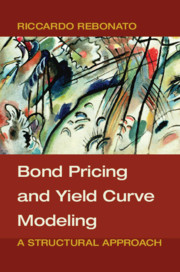Book contents
- Frontmatter
- Dedication
- Contents
- Acknowledgements
- Symbols and Abbreviations
- Part I The Foundations
- Part II The Building Blocks: A First Look
- 8 Expectations
- 9 Convexity: A First Look
- 10 A Preview: A First Look at the Vasicek Model
- Part III The Conditions of No-Arbitrage
- Part IV Solving the Models
- Part V The Value of Convexity
- Part VI Excess Returns
- Part VII What the Models Tell Us
- References
- Index
10 - A Preview: A First Look at the Vasicek Model
from Part II - The Building Blocks: A First Look
Published online by Cambridge University Press: 25 May 2018
- Frontmatter
- Dedication
- Contents
- Acknowledgements
- Symbols and Abbreviations
- Part I The Foundations
- Part II The Building Blocks: A First Look
- 8 Expectations
- 9 Convexity: A First Look
- 10 A Preview: A First Look at the Vasicek Model
- Part III The Conditions of No-Arbitrage
- Part IV Solving the Models
- Part V The Value of Convexity
- Part VI Excess Returns
- Part VII What the Models Tell Us
- References
- Index
Summary
A basic rule of [research]: if the universe hands you a hard problem, try to solve an easier one instead, and hope the simpler version is close enough to the original problem that the universe doesn't object.
Ellenberg (2014), How Not To Be WrongMy dad once gave me the following advice: “If you have a tough question that you can't answer, first tackle a simple question that you can't answer.”
Tegmark (2015), Our Mathematical UniverseTHE PURPOSE OF THIS CHAPTER
In this chapter we are going to put the cart before the horse.Out of metaphor,we are going to introduce without any proofs the simplest affine model (theVasicek model), and show its qualitative behaviour. Methodically minded readers may prefer to go through Chapters 12 to 16 first, and revisit this chapter once the theoretical foundations are firmly in place. Either way, this chapter should not be skipped.
The reason for this unseemly haste in presentation is that the Vasicek model is unsurpassed when it comes to building one's intuition about how affine models work. Whenever we look at more complex models, and our intuition begins to falter, translating the problem in Vasicek-like term (asking the question: ‘What would Vasicek do?’) is almost invariably illuminating.We therefore take a first look in this chapter at how the Vasicek model juggles our three fundamental building blocks – expectations, risk premia and convexity – to determine shape of the yield curve.
More generally, keeping the results of this chapter in mind will put some flesh around the dry bones of the theoretical treatment to follow – even if the particular Vasicek flesh may later have to be flayed away to be replaced with the more muscular structure of the later-generation affine models.
THE VASICEK MODEL
In the Vasicek (1977) model, the full yield curve is driven by a single state variable (a single factor): the short rate. It may seem that, by making this assumption, we are wagging the yield curve dog from its short-end tail.
- Type
- Chapter
- Information
- Bond Pricing and Yield Curve ModelingA Structural Approach, pp. 160 - 182Publisher: Cambridge University PressPrint publication year: 2018



